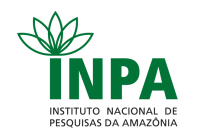Corpo Discente - Egressos
Naila Fernanda Sbsczk Pereira Meneguetti
| Título | POTENCIAL BIOTECNOLÓGICO DE OLEAGINOSAS OCORRENTES NA AMAZÔNIA OCIDENTAL BRASILEIRA | ||||||||||||||||||||||||
| Data da Defesa | 30/03/2020 | ||||||||||||||||||||||||
| Download | Visualizar a Tese(3.19MB) | ||||||||||||||||||||||||
Banca
| |||||||||||||||||||||||||
| Palavras-Chaves | Biotecnologia; Oleaginosas; Amazônia. | ||||||||||||||||||||||||
| Resumo | A utilização de espécies vegetais para tratamento ou prevenção de enfermidades é uma das mais antigas práticas medicinais na humanidade. Na Amazônia, existem inúmeras espécies de plantas que possuem potencial biotecnológico em especial as oleaginosas, foco do presente estudo que teve como objetivo geral avaliar o potencial biotecnológico dos óleos das espécies Carapa guianensis, Bertholletia excelsa e Copaifera spp., todas ocorrentes na Amazônia Ocidental Brasileira. Tendo como objetivos específicos: demonstrar o potencial biotecnológico de oleaginosas ocorrentes em comunidades extrativistas do Acre; descrever as potencialidades biotecnológicas dos óleos de C. guianensis, B. excelsa e Copaifera spp.; avaliar a atividade antibacteriana e antifúngica dos óleos de C. guianensis, B. excelsa e Copaifera spp.; e citotoxicidade, mutagenicidade e genotoxicidade dos óleos de C. guianensis e B. excelsa. Foram realizadas duas revisões bibliográficas, uma não sistemática e outra sistemática. A avaliação da atividade antibacteriana foi realizada utilizando a técnica de cup plate, contra os microrganismos Staphylococcus aureus, Streptococcus pneumoniae, Escherichia coli, Klebsiella pneumoniae e Candida albicans. Os ensaios de citotoxicidade, mutagenicidade e genotoxicidade foram realizados utilizando o sistema Allium cepa, sendo avaliado o índice mitótico e a presença de micronúcleos, aberrações cromossômicas e nucleares. Foram evidenciadas 15 espécies, pertencentes a 7 famílias (Arecaceae, Clusiaceae, Leguminosae ou Fabaceae, Lecythidaceae, Malvaceae, Meliaceae, Myristicaceae) de oleaginosas, com potencial biotecnológico ocorrentes nas comunidades extrativistas do estado do Acre. Os dados mostram que essas oleaginosas pesquisadas, possuem potencial para a indústria de alimentos (com grande potencial nutricional), indústria de cosméticos e principalmente para indústria, farmacológica. A revisão sistemática demonstrou que as espécies C. guianensis e Copaifera spp., são fortes candidatas para busca de novos produtos com atividade inseticida, antiparasitária, anti-inflamatória e cicatrizante. A espécie Copaifera spp. também demonstrou ser promissora para a produção de antibióticos e antifúngicos e a espécie C. guianensis para drogas acaricidas. Foi observado que os óleos de C. guianensis, B. excelsa e Copaifera spp., não apresentaram atividade inibitória de S. aureus, S. pneumoniae, E. coli, K. pneumoniae e C. albicans. Constatou-se que os óleos de B. excelsa e C. guianensis, não apresentaram ação citotóxica sobre células meristemáticas de A. cepa. O óleo de B. excelsa também não apresentou ação mutagênica e genotóxica, diferentemente do óleo de C. guianensis que demonstrou tanto atividade mutagênica como genotóxica na concentração testada. | ||||||||||||||||||||||||
| Abstract | The use of plant species to treat or prevent diseases is one of the oldest medicinal practices in humanity. In the Amazon, there are countless species of plants that have biotechnological potential, especially oilseeds, the focus of the present study, that aimed to evaluate the biotechnological potential of oils from the species Carapa guianensis, Bertholletia excelsa and Copaifera spp., all occurring in the Western Brazilian Amazon. The specific objectives: to demonstrate the biotechnological potential of oilseeds occurring in extractive communities in Acre; to describe the biotechnological potential of oils from C. guianensis, B. excelsa and Copaifera spp.; to evaluate the antibacterial and antifungal activity of the oils of C. guianensis, B. excelsa and Copaifera spp.; and cytotoxicity, mutagenicity and genotoxicity of the oils of C. guianensis and B. excelsa oils. Two bibliographic reviews were carried out, one non-systematic and the other systematic. The evaluation of antibacterial activity was performed using the cup plate method, against the microorganisms Staphylococcus aureus, Streptococcus pneumoniae, Escherichia coli, Klebsiella pneumoniae and Candida albicans. The cytotoxicity, mutagenicity and genotoxicity tests were performed using the Allium cepa test, evaluating the mitotic index and the presence of micronuclei, chromosomal and nuclear aberrations. There were evidenced 15 species, belonging to 7 families (Arecaceae, Clusiaceae, Leguminosae or Fabaceae, Lecythidaceae, Malvaceae, Meliaceae, Myristicaceae) of oilseeds, with biotechnological potential occurring in the extractive communities of the state of Acre. The data show that these oilseeds have potential mainly for the food (with great nutritional potential), cosmetics and pharmaceutical industry. The systematic review showed that the species C. guianensis and Copaifera spp., are strong candidates to explore the development for new products with insecticidal, antiparasitic, anti-inflammatory and healing activities. Copaifera spp. also proved to be promising for antibiotics and antifungals production and C. guianensis for acaricidal drugs. It was observed that the oils of C. guianensis, B. excelsa and Copaifera spp., did not show inhibitory activity by S. aureus, S. pneumoniae, E. coli, K. pneumoniae and C. albicans. It was found that the oils of B. excelsa and C. guianensis, had no cytotoxic effect on meristematic seed cells of A. cepa. B. excelsa oil also did not present mutagenic and genotoxic effect, contrasting C. guianensis oil, which demonstrated both mutagenic and genotoxic activity in the tested concentration. | ||||||||||||||||||||||||
Parceiros

























